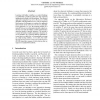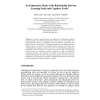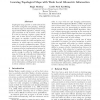194 search results - page 6 / 39 » Learning whom to trust: using graphical models for learning ... |
AAAI
1994
13 years 8 months ago
1994
Researchers in the eld of Distributed Arti cial Intelligence (DAI) have been developing e cient mechanisms to coordinate the activities of multiple autonomous agents. The need for...
UAI
2003
13 years 8 months ago
2003
Learning with hidden variables is a central challenge in probabilistic graphical models that has important implications for many real-life problems. The classical approach is usin...
KDD
2009
ACM
13 years 12 months ago
2009
ACM
We develop and evaluate an approach to causal modeling based on time series data, collectively referred to as“grouped graphical Granger modeling methods.” Graphical Granger mo...
ECTEL
2006
Springer
13 years 11 months ago
2006
Springer
To provide personalization and adaptivity in technology enhanced learning systems, the needs of learners have to be known by the system first. Detecting these needs is a challengin...
IJCAI
1997
13 years 8 months ago
1997
cal maps provide a useful abstraction for robotic navigation and planning. Although stochastic mapscan theoreticallybe learned using the Baum-Welch algorithm,without strong prior ...



